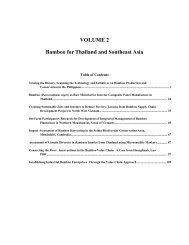WBC-VIII-Vol.4 – Resources – Forestry, Plantations and ... - BambuSC
WBC-VIII-Vol.4 – Resources – Forestry, Plantations and ... - BambuSC
WBC-VIII-Vol.4 – Resources – Forestry, Plantations and ... - BambuSC
Create successful ePaper yourself
Turn your PDF publications into a flip-book with our unique Google optimized e-Paper software.
Succession of Bamboo (Phyllostachys bambusoides Sieb. et Zuc.)<br />
Riparian Forest Vegetation after Gregarious Flowering<br />
Abstract<br />
Shibata, Shozo<br />
Field Science Education <strong>and</strong> Research Center, Kyoto University, Japan<br />
Ecological research of Phyllostachys bambusoides riparian forest was practiced for 16 years from about 20 years<br />
after gregarious flowering. As a result it was indicated that the recovering vigorousness of P. bambusoides after<br />
flowering was continued at least for 25 years. Tree species were suppressed by bamboo again during the<br />
research. The bamboo forest vegetation is considered to need more than 25 years after bamboo flowering to<br />
stable the vegetation condition. Moreover, at the stable <strong>and</strong> unmanaged P. bambusoides forests, it is shown that<br />
a large amount of new culms is produced on every two or three years, <strong>and</strong> the culms of the following year are<br />
comparatively small <strong>and</strong> die young.<br />
Introduction<br />
In Japan, most of Phyllostachys bambusoides Siebold et Zuccarini flowered gregariously <strong>and</strong> died from the end<br />
of 1960’s to the beginning of 1970’s (Kasahara 1971). In this gregarious flowering, it was recorded that little<br />
seeds were produced <strong>and</strong> almost all the P. bambusoides populations regenerated by unique behavior. Although<br />
this report is not aimed to notice this regeneration system, this was asexual reproduction by the sprouting of next<br />
generation bamboo shoots from new rhizomes.<br />
This flowering gave severe damages to the bamboo industries in Japan. After that, most of the bamboo<br />
industries ab<strong>and</strong>oned to get bamboo timbers from their local areas. Notwithst<strong>and</strong>ing most P. bambusoides<br />
forests recovered in a following decade, the new system to get bamboo timbers was not restored to its former<br />
state. At the same time, just after the flowering, many bamboo forests were converted to the other l<strong>and</strong> uses. To<br />
obtain the materials for bamboo industries, much of them were not harvested in local areas <strong>and</strong> are purchased<br />
not only from other domestic areas but also from foreign countries. At present time, many recovering P.<br />
bambusoides forests in Japan are under unmanaged condition <strong>and</strong> scarce of constant management. As a result,<br />
in many bamboo forests the density control is not practiced, therefore, the quality of the produced bamboo<br />
timber from such kind of bamboo forests is very low.<br />
Here, it is reported the results of the ecological research for 16 years at the unmanaged P. bambusoides riparian<br />
forest, which is very common condition in Japan now, <strong>and</strong> of the analyses of the vegetation succession in mixed<br />
bamboo forest with broad-leaved trees following to the recovery of bamboo after flowering.<br />
<strong>VIII</strong> World Bamboo Congress Proceedings Vol 4-139




